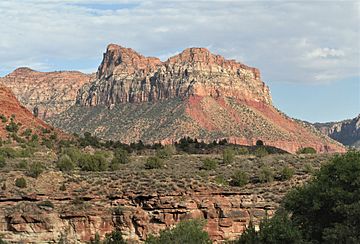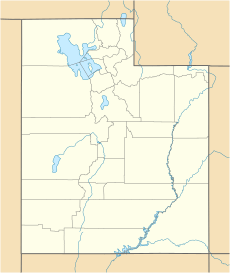Shunesburg Mountain facts for kids
Quick facts for kids Shunesburg Mountain |
|
|---|---|

Shunesburg Mountain, west aspect
|
|
| Highest point | |
| Elevation | 5,960 ft (1,820 m) |
| Prominence | 640 ft (200 m) |
| Isolation | 1.3 mi (2.1 km) |
| Parent peak | Transview Mountain (6,321 ft) |
| Geography | |
| Location | Zion National Park Washington County, Utah United States |
| Parent range | Colorado Plateau |
| Topo map | USGS Springdale East |
| Geology | |
| Age of rock | Jurassic |
| Type of rock | Navajo sandstone |
Shunesburg Mountain is a tall peak, about 5,960 feet (1,817 meters) high. It's located inside Zion National Park in southwest Utah, United States. This mountain is a cool spot to explore in the park!
Contents
About Shunesburg Mountain
Shunesburg Mountain stands about 3.4 miles (5.5 km) southeast of a town called Springdale. It rises 2,000 feet (600 meters) above the bottom of Parunuweap Canyon. The mountain is nestled between Shunes Creek and the East Fork Virgin River. These waterways collect rain and snowmelt from the mountain.
How the Mountain Got Its Name
This mountain is named after a ghost town called Shunesburg. A ghost town is a place where people used to live, but now it's empty. Shunesburg was located between the west side of this mountain and Johnson Mountain.
The town itself was named after Chief Shunes, a leader of the Southern Paiute people. In 1861, Chief Shunes sold the land to Mormon settlers who tried to build a community there. However, the Virgin River often flooded, making it hard to live there. Because of the floods, the settlers eventually had to leave. They moved to a nearby town called Rockville.
Weather and Climate
The best times to visit Shunesburg Mountain are in the spring and fall. The weather is usually very pleasant then.
Understanding the Climate
Shunesburg Mountain is in a place with a Cold semi-arid climate. This means it's a desert climate, but it can get cold. The coldest month of the year has an average temperature below 32 °F (0 °C). Also, more than half of the yearly rain and snow falls during spring and summer.
This desert area gets less than 10 inches (254 mm) of rain each year. Snowfall in the winter is usually light, so it doesn't get very deep.



